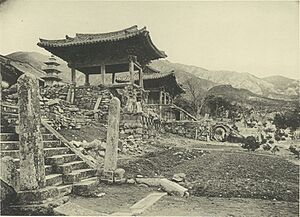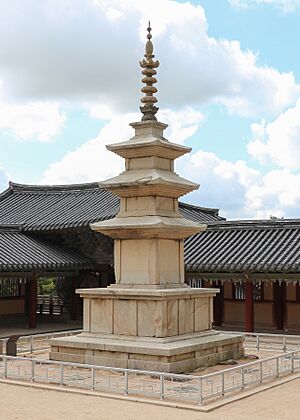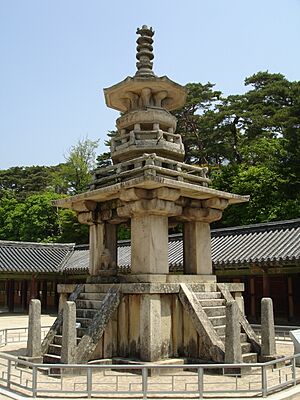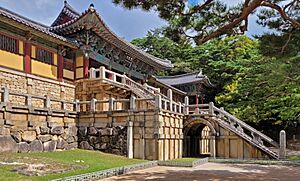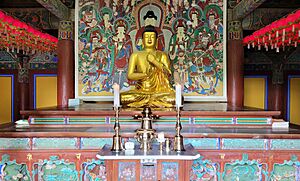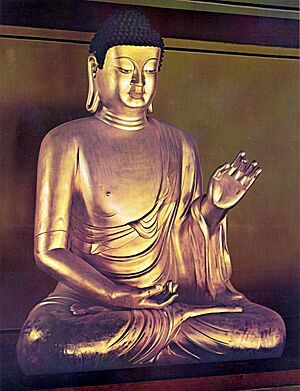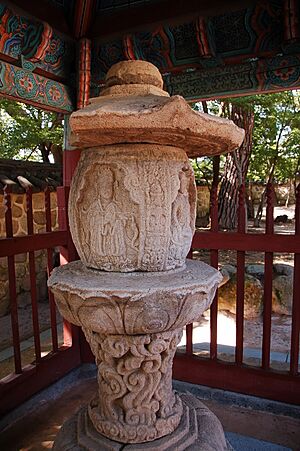Bulguksa facts for kids
Quick facts for kids Bulguksa |
|
|---|---|
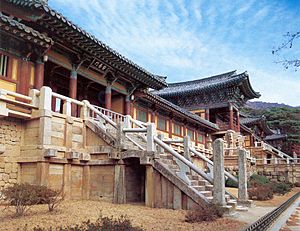 |
|
| Religion | |
| Affiliation | Buddhism |
| Sect | Jogye Order |
| Location | |
| Location | Gyeongju, South Korea |
| Official name: Bulguksa Temple | |
| Criteria | Cultural: i, iv |
| Designated | 1995 |
| Parent listing | Seokguram Grotto and Bulguksa Temple |
| Reference no. | 736 |
|
Invalid designation
|
|
| Official name: Bulguksa Temple, Gyeongju | |
| 2009-12-21 | |
| 502 | |
Bulguksa (Korean: 불국사) is one of the most famous and beautiful Buddhist temples in South Korea. It is located on Tohamsan mountain, near the city of Gyeongju.
This temple is a true treasure chest of Korean history and art. It holds six official National Treasures. These include the famous stone pagodas, Dabotap and Seokgatap, and beautiful ancient bridges.
Bulguksa is considered a masterpiece from the golden age of the ancient Silla kingdom. Because of its importance, UNESCO added Bulguksa and the nearby Seokguram Grotto to the World Heritage List in 1995. It is a major center for Korean Buddhism today.
Contents
Discovering the History of Bulguksa Temple
Early Beginnings in the Silla Kingdom
The first records suggest a small temple was built here around 528 AD. This was during the reign of King Beopheung of Silla.
The grand temple we see today started construction much later, around 751 AD. Chief Minister Kim Daeseong began the project. He wanted to honor his parents' spirits.
The Silla royal court finished the temple in 774 AD, after Kim Daeseong passed away. They named it Bulguksa, which means "Temple of the Buddha Land."
The Discovery of an Ancient Print
In 1966, a very important discovery was made at Bulguksa. Researchers found one of the earliest woodblock prints in the world here.
This print was a version of the Dharani sutra. It is dated between 704 and 751 AD. The Buddhist text was printed on a long scroll of mulberry paper.
Challenges and Rebuilding
Bulguksa was an important site for centuries. It was renovated many times during the Goryeo and early Joseon Dynasties.
Sadly, during the wars in the late 16th century (the Imjin wars), the temple's wooden buildings were destroyed by fire.
Starting in 1604, people began the long process of rebuilding and expanding Bulguksa. It underwent about 40 renovations until 1805.
Modern Restoration Efforts
After years of neglect, major restoration work began in the 20th century. A partial restoration happened in 1966.
Between 1969 and 1973, a huge restoration project took place. This brought Bulguksa back to its magnificent Silla-era appearance.
The famous stone structures, like the bridges and pagodas, are the original parts from the Silla kingdom. They have survived over 1,300 years!
Exploring the Architecture of Bulguksa
Bulguksa is built on the slopes of Tohamsan mountain. The layout of the temple represents the terrestrial world and the celestial world of the Buddha.
The Unique Stairway Bridges
The main entrance, called Sokgyemun, features a special double-sectioned stairway. This stairway is also a bridge.
The stairway has 34 steps in total.
- The upper section is the Cheongungyo (Blue Cloud Bridge).
- The lower section is the Baegungyo (White Cloud Bridge).
These bridges lead up to the Jahamun Gate.
The Two Famous Pagodas: Dabotap and Seokgatap
It is unusual for a temple to have two main pagodas in its courtyard. Bulguksa has two, and they are very different!
Seokgatap: The Simple Pagoda
The Seokgatap (Sakyamuni Pagoda) is 8.2 meters tall. It is a traditional Korean stone pagoda.
It has simple, clean lines and minimal decoration. This pagoda is over 13 centuries old.
Dabotap: The Ornate Pagoda
The Dabotap (Many Treasure Pagoda) is 10.4 meters tall. It is dedicated to the Buddha of Many Treasures.
In contrast to Seokgatap, Dabotap is famous for its highly detailed and ornate structure. It looks very complex and decorative.
You might have seen Dabotap before! Its image is featured on the South Korean 10 won coin.
Main Halls and Shrines
The temple complex is organized around two main courtyards.
- The main hall is Daeungjeon (Hall of Great Enlightenment). This is where the Sakyamuni Buddha is enshrined. The two famous pagodas stand in front of this hall.
- Behind the main hall stands Museoljeon (Hall of No Words). This is one of the oldest buildings here. It gets its name from the idea that the deepest Buddhist teachings cannot be explained using only words.
The Gwaneumjeon (Avalokitesvara's Shrine) is located at the highest point of the complex. It houses the image of the Bodhisattva of Perfect Compassion.
The Geuknakjeon (Hall of Supreme Bliss) is another important hall. It houses a famous gilt-bronze Buddha statue (National Treasure No. 27).
Bulguksa's National Treasures
Bulguksa is home to several items officially designated as National Treasures. These artifacts are protected because of their immense historical and artistic value.
Pagodas: Treasures No. 20 and 21
The Dabotap (No. 20) and Seokgatap (No. 21) pagodas are the most famous treasures here. They were designated as National Treasures in 1962. They stand side-by-side, showing the contrast between ornate and simple Silla architecture.
Yeonhwagyo and Chilbogyo Bridges (No. 22)
The Yeonhwagyo (Lotus Flower Bridge) and Chilbogyo (Seven Treasures Bridge) form another pair of bridges. They lead to the Geuknakjeon (Hall of the Pure Land).
Like the other bridges, they combine a staircase and a bridge design. They are smaller than the Blue and White Cloud Bridges.
The lower Lotus Flower Bridge once had delicate carvings of lotus flowers on each step. To protect these ancient carvings, visitors are no longer allowed to walk on this bridge.
Cheongungyo and Baegungyo Bridges (No. 23)
These two bridges form the main stairway leading into the temple complex. They were likely built around 750 AD. They are designated together as National Treasure No. 23.
The Cheongungyo (Blue Cloud Bridge) is the upper part. The Baegungyo (White Cloud Bridge) is the lower part.
The stairway has 34 steps and slopes steeply. The large arch underneath shows the advanced Silla engineering used in bridge building.
Gilt-Bronze Vairocana Buddha (No. 26)
This is a seated gilt-bronze statue of the Vairocana Buddha (the Buddha of Enlightenment). It is enshrined in the Birojeon hall.
The statue is 1.77 meters tall. Experts believe it was created around the 9th century.
The Buddha's hands are positioned in a specific way. This gesture symbolizes the supreme wisdom of enlightenment.
Gilt-Bronze Amitabha Buddha (No. 27)
This seated gilt-bronze statue of the Amitabha Buddha is enshrined in the Geuknakjeon hall. It is 1.66 meters tall.
This statue also dates back to the late 8th or early 9th century. It shares a similar artistic style with Treasure No. 26.
The statue has broad shoulders and a strong chest. This gives the figure a sense of balance and stability.
Sarira Pagoda (Treasure No. 61)
This stone structure is a sarira pagoda, or stupa. It is 2.1 meters tall and looks somewhat like a stone lantern.
A sarira is a container used to hold the relics or remains of important priests or royalty. This pagoda is believed to be from the Goryeo Dynasty.
The pagoda features detailed carvings, including lotus motifs and cloud designs. It was briefly taken to Japan but was returned to Bulguksa in 1933.
See also
 In Spanish: Bulguksa para niños
In Spanish: Bulguksa para niños
- Korean Buddhist temples
- List of South Korean tourist attractions
- List of Buddhist topics
- Tourism in Gyeongju
Images for kids


